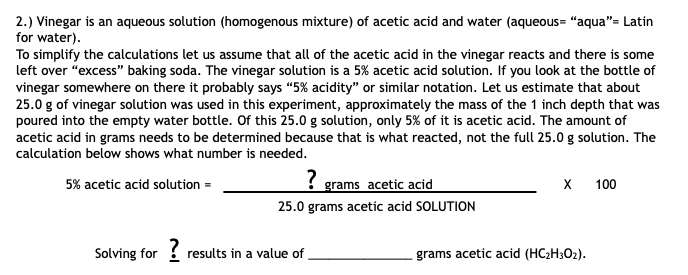2.) Vinegar is an aqueous solution (homogenous mixture) of acetic acid and water (aqueous= "aqua"= Latin for water). To simplify the calculations let us assume that all of the acetic acid in the vinegar reacts and there is some left over "excess" baking soda. The vinegar solution is a 5% acetic acid solution. If you look at the bottle of vinegar somewhere on there it probably says “5% acidity" or similar notation. Let us estimate that about 25.0 g of vinegar solution was used in this experiment, approximately the mass of the 1 inch depth that was poured into the empty water bottle. Of this 25.0 g solution, only 5% of it is acetic acid. The amount of acetic acid in grams needs to be determined because that is what reacted, not the full 25.0 g solution. The calculation below shows what number is needed. ? grams acetic acid X 100 5% acetic acid solution = 25.0 grams acetic acid SOLUTION Solving for results in a value of, ? grams acetic acid (HC2H3O2).
2.) Vinegar is an aqueous solution (homogenous mixture) of acetic acid and water (aqueous= "aqua"= Latin for water). To simplify the calculations let us assume that all of the acetic acid in the vinegar reacts and there is some left over "excess" baking soda. The vinegar solution is a 5% acetic acid solution. If you look at the bottle of vinegar somewhere on there it probably says “5% acidity" or similar notation. Let us estimate that about 25.0 g of vinegar solution was used in this experiment, approximately the mass of the 1 inch depth that was poured into the empty water bottle. Of this 25.0 g solution, only 5% of it is acetic acid. The amount of acetic acid in grams needs to be determined because that is what reacted, not the full 25.0 g solution. The calculation below shows what number is needed. ? grams acetic acid X 100 5% acetic acid solution = 25.0 grams acetic acid SOLUTION Solving for results in a value of, ? grams acetic acid (HC2H3O2).
Chapter1: Chemical Foundations
Section: Chapter Questions
Problem 4ALQ
Related questions
Question

Transcribed Image Text:2.) Vinegar is an aqueous solution (homogenous mixture) of acetic acid and water (aqueous= "aqua"= Latin
for water).
To simplify the calculations let us assume that all of the acetic acid in the vinegar reacts and there is some
left over "excess" baking soda. The vinegar solution is a 5% acetic acid solution. If you look at the bottle of
vinegar somewhere on there it probably says “5% acidity" or similar notation. Let us estimate that about
25.0 g of vinegar solution was used in this experiment, approximately the mass of the 1 inch depth that was
poured into the empty water bottle. Of this 25.0 g solution, only 5% of it is acetic acid. The amount of
acetic acid in grams needs to be determined because that is what reacted, not the full 25.0 g solution. The
calculation below shows what number is needed.
5% acetic acid solution =
{ grams acetic acid
х 100
25.0 grams acetic acid SOLUTION
Solving for results in a value of
?
grams acetic acid (HC2H3O2).
Expert Solution
This question has been solved!
Explore an expertly crafted, step-by-step solution for a thorough understanding of key concepts.
This is a popular solution!
Trending now
This is a popular solution!
Step by step
Solved in 2 steps

Knowledge Booster
Learn more about
Need a deep-dive on the concept behind this application? Look no further. Learn more about this topic, chemistry and related others by exploring similar questions and additional content below.Recommended textbooks for you


Chemistry
Chemistry
ISBN:
9781305957404
Author:
Steven S. Zumdahl, Susan A. Zumdahl, Donald J. DeCoste
Publisher:
Cengage Learning

Chemistry: Principles and Reactions
Chemistry
ISBN:
9781305079373
Author:
William L. Masterton, Cecile N. Hurley
Publisher:
Cengage Learning


Chemistry
Chemistry
ISBN:
9781305957404
Author:
Steven S. Zumdahl, Susan A. Zumdahl, Donald J. DeCoste
Publisher:
Cengage Learning

Chemistry: Principles and Reactions
Chemistry
ISBN:
9781305079373
Author:
William L. Masterton, Cecile N. Hurley
Publisher:
Cengage Learning

Chemistry & Chemical Reactivity
Chemistry
ISBN:
9781337399074
Author:
John C. Kotz, Paul M. Treichel, John Townsend, David Treichel
Publisher:
Cengage Learning

Chemistry: Principles and Practice
Chemistry
ISBN:
9780534420123
Author:
Daniel L. Reger, Scott R. Goode, David W. Ball, Edward Mercer
Publisher:
Cengage Learning

Chemistry: An Atoms First Approach
Chemistry
ISBN:
9781305079243
Author:
Steven S. Zumdahl, Susan A. Zumdahl
Publisher:
Cengage Learning